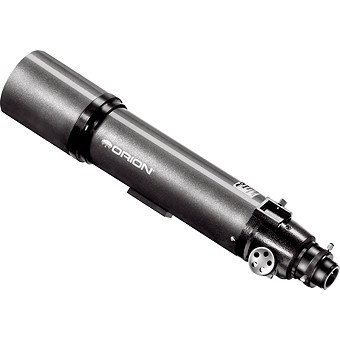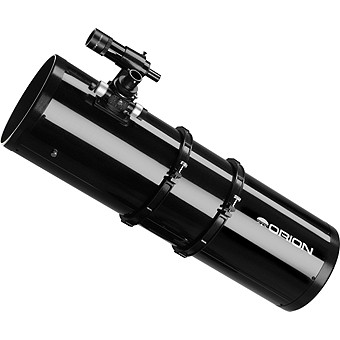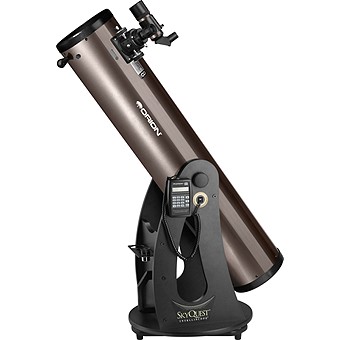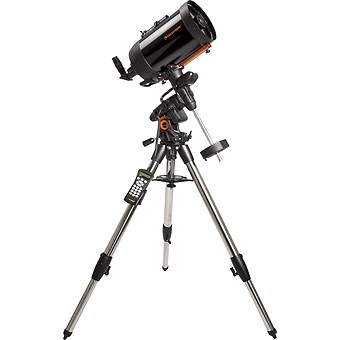How To Avoid The Agony When Buying Your First Telescope
DISCLOSURE: This post may contain affiliate links, meaning when you click the links and make a purchase, we receive a commission.

Buying your first telescope can quickly become a daunting task when faced with so many choices and unfamiliar terms. With everything from cheap department store telescopes to computerized models and specialized APO refractors, how do you choose something you’ll be able to enjoy for years with without spending a fortune?
If you are like me, when it comes to buying something like a telescope, you want to do your research to make sure you purchase something you’ll be happy with. I spent several months researching what telescope to buy, and I really didn’t find most of the “how to choose your first telescope” articles out there all that helpful. Hopefully this article simplifies the process a bit for you.
Some questions you want to consider when shopping for your first telescope:
- How far will you need to move the telescope to setup and use it?
- What do you want to look at? The moon, planets, bright nebula, double-stars, galaxies?
- How much do you want to spend?
- Do you want to do visual observing or astrophotography?
The sections below should help you think through some of those questions and narrow down your choices.
Price
The adage “you get what you pay for” has an interesting application with telescopes. It isn’t a linear value curve; rather it tends to be more of a bell shape. Spend too little, and you wind up with something like the red Tasco telescope I got as a kid that was really only good for looking at the moon and taking up a dusty corner of the garage. At the same time, you don’t need to spend a fortune to get a telescope that will bring you years of enjoyment.

Just keep in mind that you are buying a precision optical instrument, and quality convex lenses and concave mirrors are difficult to make, so when you see a shiny $100 telescope with a whole set of eyepieces and a tripod, you can be pretty sure there were a lot of sacrifices made that will leave you disappointed with the view you get through it. At the same time, you don’t need to spend thousands on professional quality gear, unless of course you want to start hunting for undiscovered asteroids.
So how much should you spend? That’s a question you need to answer for yourself based on what you can spend and how much enjoyment you expect to get out of observing the universe. In general, expect to spend $300 at the bottom end for a quality instrument, and up to about $2000 for a large aperture computerized scope. If your interest is astrophotography, you can find good options across that range, depending on what you want to image. More on that later.
Types of Telescopes
Here’s a helpful analogy: Think of buying a telescope like buying your mode of transportation to the cosmos. That cheap department store telescope that also comes bundled with a microscope? Think of that as being like a little Razor scooter: It won’t get you very far, it’s more than a little shaky, and will probably fall apart after a few weeks.
Taking a step up, you have the basic Refractor and Newtonian scopes on manual alt-azimuth mounts in the $100-$200 range. These are like Bicycles: You can go a lot further than a Razor scooter, but you still can’t go down the freeway. Incidentally, anything with a computerized mount in that $200 price range is likely going to have relatively poor optics, so don’t be tempted. These scopes may seem like a bargain at first, but chances are they’ll only get used a couple of times before going into the basement.
Once we get past the cruft, there are 4 different types of telescopes of note for serious beginner and intermediate astronomers: Refractors, Newtonians, Dobsonians, and Schmidt-Cassegrains. These telescopes are like cars: You can take them a long distance, and you have a lot of choices concerning your type of vehicle. Now you need to decide if you want a basic sedan, a sports car, a minivan, a pickup truck, or an SUV.
Refractors, The Sedans and Sports Cars

One limitation common to refractors in the lower price bracket is Chromatic Aberration. You can think of this simply as color fringing and blurring of the object. This happens because the different frequencies of light (the rainbow of colors) don’t all refract exactly the same. Just think of sunlight through a prism where you see a rainbow effect. The same applies to refracting light through the lenses of a telescope. This is going to be more pronounced with bright objects like the moon and planets, but not generally noticeable with dimmer stars. As prices go up in this category, it’s primarily attributable to aperture (the diameter of the primary lens) and perfecting the optics to reduce the Chromatic Aberration. You can actually get refractors called Apochromatics, or APOs that have effectively no chromatic aberration and are excellent for wide-field astrophotography, but the prices for these scopes start at around $700 for just the telescope body.
Pros:
- Good general-purpose telescopes
- Wide Field Views
Cons:
- Above about 100mm, very high cost per inch of aperture.
- Prone to chromatic aberration
Notes:
- Watch of out very poor optical quality with cheap scopes.
Newtonian Reflectors, The MiniVans

Dobsonians, The Pickup Trucks

Pros:
- Best value per inch of aperture
- Excellent for visual observing of planets and deep space objects
- Simple setup
Cons:
- Not well suited to astrophotography, except for short exposure planetary imaging.
- Bulky tubes and bases can be awkward to transport and store.
Notes:
- Some Dobsonians also offer Goto computers to help you find and track objects. It’s up to you to decide if this feature is worth the added cost (typically about $200).
Schmidt-Cassegrains, The SUVs

Pros:
- Better value per inch of aperture than refractors above 100mm
- Excellent for Astrophotography
- Smallest physical size for the largest aperture
Cons:
- More expensive than Newtonian/Dobsonian telescopes for the same aperture
Notes:
- Generally narrower field of view than other types of scopes
Size vs. Portability
When shopping for your first telescope, once you’ve gotten past the cheap department store offerings (we’ll get to those in a moment), it can be easy to get carried away with aperture fever. Aperture simply refers to the diameter of the primary lens or mirror of the telescope, typically measured in millimeters or inches. The larger the aperture of the telescope, the more light gathering power it has, which allows you to see fainter objects and more detail in brighter objects. To see those dimmer messier objects and distant galaxies, an 8” (200mm) aperture is about the minimum. So, to get the best views, you want the most aperture you can afford… except for when you don’t.
Larger aperture telescopes are, well, bigger and consequently heavier and bulkier. Before you pick a telescope, think carefully about where and how you will want to use your telescope, and where you’ll be storing it. If you live on a 7th floor apartment with no elevator, trying to move a large and heavy telescope will probably quickly start to seem like more trouble than it’s worth. A telescope that lets you see the faintest of objects isn’t any good if you don’t want to use it. In this case, you’re much better off with a smaller telescope that’s easily portable. On the other hand if you plan to keep your telescope in the garage and move it no further than the driveway to use, you can definitely consider a much larger scope.
Be mindful that many telescopes are actually physically larger in real life than you might think they are looking at pictures online. If possible, it’s always a good idea to look at a telescope in person. Better yet, look through several at a local star party.
Ignore Magnification
Department store telescopes will often advertise magnifying power – something like “200x” or “400x”. If you see a telescope advertising this, walk away. Magnifying power is a marketing gimmick for low-quality instruments. This is because you can put a “high power” eyepiece on basically any telescope and get a ridiculously high magnification power, but unless the telescope has a large enough aperture and quality optics to support that magnification, you won’t be able to get a sharp image. That “high power” eyepiece itself is probably also going to be very optically poor.
A simple rule of thumb is the maximum useful magnification of a telescope is going to be the aperture in millimeters multiplied by 2. (If the aperture is listed in inches, multiply the aperture by 50). There is however an upper limit of about 300x. Even if you have a 12″ aperture telescope, due to atmospheric conditions the maximum useful magnification is about 300x, and that’s on a good night with little air turbulence.
Astrophotography
If you want to explore astrophotography, there are a few additional considerations.
Cameras
If you don’t already have a basic DSLR camera, my best advise here is that your first purchase should be an entry level DSLR, and the telescope can come later. Even with a standard camera lens and a tripod you can take wonderful photos of constellations and night sky landscapes, and the occasional bright comet.
Basic DSLRs, particularly models a year or two old like the Canon EOS Rebel T5 start around $400-500, but you can find recent models used or refurbished as low as about $300. Specific models to consider would be the Canon EOS Rebel T5i or the just announced Canon EOS Rebel T6s. These and similar DSLR cameras can be easily connected to a telescope with inexpensive adapters. Plus, you get a great quality general purpose DSLR camera for daytime use.
Telescopes & Mounts
If you plan to take long exposure photos (and if you want to photograph deep space objects, you need to) then you should seriously consider purchasing a telescope with a computerized German Equatorial Mount. GEMs as they are often called use a counterweight system to balance the telescope, with one axis adjusted to match your latitude. This somewhat increases the complexity of use and raises the entry price, but there are two good reasons to spend a bit more here. First, a computerized GEM will track an object along a single axis as the earth rotates. This creates smoother tracking than an alt-az mount that has to constantly adjust both axis. Second, an EQ mount rotates the scope in sync with the sky as it tracks. Using an alt-az mount, you’ll discover that two photos of the same object taken an hour apart will be rotated in the frames. You can correct for this in post-processing, but if you are serious about doing astrophotography with your telescope, an EQ mount is worth the extra cost and effort. Celestron has great astrophotography starter telescopes in their new VX line, specifically the Celestron Advanced VX 6″ Schmidt-Cassegrain Telescope. (This is effectively a newer model of the same telescope and mount I own.)
Final Thoughts
Ideally you want to get a feel for different types of telescopes for yourself before you buy. Star Parties are probably the best way to do this. Check out the Night Sky Network sponsored by NASA to find an astronomy club near you. Almost every astronomy club hosts public star parties where you can have a chance to look through a number of different scopes and ask questions of other amateur astronomers.
Other information you’d like to see? Have a different view? Please leave a comment!

Share your thoughts